First of all, what is a constellation?
Before we dive deep into the Musca constellation, lets look first at what a constellation actually is. Basically, it’s a group of Stars.
A constellation is an area on the celestial sphere (an imaginary sphere) where a group of visible stars are located. These stars typically form a pattern or outline, which we perceive to represent an inanimate object, (like a Cross, Crux), an animal (like the fly, or a lizard), a mythical person (like the Hunter), or even a type of creature (like Phoenix, or Cetus), from Greek mythology.
It is also an astronomy term used to describe a variety of groups of stars that have been given a specific name such as –
Constellations are constantly moving and move in the direction from East to West.
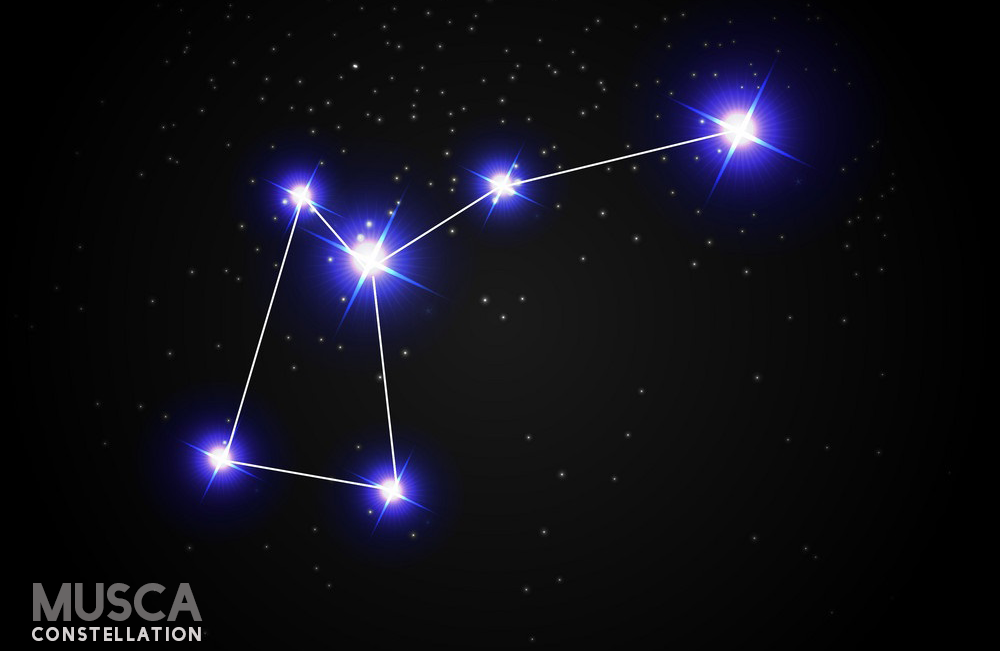
The Constellation Musca– Facts in brief:
What is it? –
Musca, the southern fly Constellation, is regarded as a fairly small and faint constellation in the Southern Hemisphere.
It is listed as the 77th largest Constellation as it fills around 0.3% of the night sky.
The Musca Constellation is not associated with any ancient myths but it is believed to resemble the shape of the fly, located beside a watchful sort of lizard (the Constellation Chamaeleon).
The name ‘Musca’ is Latin for the fly and its Latin genitive ‘Muscae’ and a common abbreviation is ‘Mus’.
Its outline forms the shape of an insect from the position of its six brightest Stars, in the Southern Sky.
It is best seen in the month of May.
Where is it located? –
The Musca Constellation is positioned in the third quadrant of the Southern Hemisphere, south of the ecliptic plane (which is different from the celestial equator).
Being located south of the celestial equator makes it more visible from the Southern Hemisphere.
It is sometimes referred to as being located in the SQ3 Quadrant.
FACT: The ecliptic is the imaginary line tracing the route that The Sun, the Moon, and the Planets take across the sky, over the year.
Musca is one of the more southern located constellations that are close to the south celestial pole.
The south celestial pole is positioned in its neighboring Constellation Octans.
Musca is one of the Constellations that is so far south it can only be seen in the southern hemisphere.
The Constellation of Musca is circumpolar across much of the Southern Hemisphere, although it appears at its highest in the late night sky around the month of May.
The true Circumpolar Constellations
There are 5 Constellations that are visible throughout the year, from most locations located north of the celestial equator, making them Circumpolar, they are:
- Cassiopeia Constellation
- Cepheus Constellation
- Draco Constellation
- Ursa Major Constellation
- Ursa Minor Constellation
FACT: A constellation that is visible all year round is known as a Circumpolar Constellation.
There are 3 Southern Constellations that are also circumpolar –
- Carina Constellation
- Centaurus Constellation
- Crux Constellation (also known as the southern cross)
Where can it be seen?
Co-ordinates of a right ascension, or left ascension and their declination are used to locate all of the Constellations, like Musca.
Musca is most prominent in the Southern Hemisphere.
The Musca Constellation lies at a 13 hours right ascension and a declination of 70 degrees South.
It’s more easily visible from the Southern Hemisphere at latitudes between +10 degrees and -90 degrees and covers an area of 138 square degrees in the Southern sky.
The right ascension – is the angular distance of any sky object along the celestial equator from the March (Spring) equinox.
- If it has a negative number it is west of the March equinox.
The declination – is the angle of the sky object from the celestial equator.
- If it has a negative number it indicates it is located in the southern hemisphere
How was it formed, found and named?
Sea navigators, explorers, astronomers, and cartographers, throughout the ages, have observed the Constellations.
The Musca Constellation is not one of the original 48 Constellations devised and catalogued by the Greek astronomer Claudius Ptolemy, around 140 AD.
The Dutch influence
It was in the 16th Century, around 1595, that the first Dutch sea voyage to the East Indies took place.
These voyages enabled Dutch navigators and cartographers Pieter Dirkszoon Keyser and Frederick de Houtman, (students of Petrus Plancius) to make astronomical observations on their sea voyages of the bright stars and constellations in the southern sky.
It was on one such voyage to the East Indies that Pieter Dirkszoon Keyser cataloged around 130 Stars and recorded 12 new Constellations in the Southern Sky.
It was in fact the Dutch astronomer Petrus Plancius who is credited with the creation of this constellation and introduced it to the world in the late 16th Century as Keyser had died before returning from this voyage.
Keyser’s colleague Frederick de Houtman first included it in his Southern Star Catalogue as the Dutch word ‘De Vlieghe’ (the fly). He helped his tutor Petrus Plancius to name the 12 Constellations from their observations on his return from the East Indies voyage.
Possible Origins for the name Musca
The Constellation Musca was perhaps named after an insect (from the family insecta), such as a bee or the fly. It is possibly in reference to the various insects they saw during their travels around Madagascar, South Africa or the East Indies.
Petrus Plancius depicted the Constellation now known as Musca on a celestial globe in 1592, although it was left unnamed at this point in time.
Later, in 1603, the Constellation of Musca was listed in Johann Bayer’s Uranometria, although he referred to it as the Constellation Apis, meaning the ‘Bee’. (Uranometria is a well-known Star Atlas compiled by German astronomer Johann Bayer).
In 1756 the French astronomer, Nicolas Louis de Lacaille called it ‘La Mouche’, in his records of the Southern Sky. He later renamed it Musca Australis, the Southern fly to distinguish it from the now defunct Constellation of Musca Borealis, which was composed of a few Stars in Constellation Aries.
Musca fills an area of 138 square degrees.
- Initially, the shapes of their star patterns informally categorized the image we had of a constellation
- Eventually, the International Astronomical Union (IAU) published the official listing of constellation boundaries, mapping the constellations by their sky coordinates not by their line patterns and shapes.
The Musca Constellation is one of the 88 Constellations within the celestial sphere that is listed in the official IAU chart published by the International Astronomical Union (IAU).
How can you identify The Constellation Musca?
The simplest method for spotting any particular Constellation from Earth is to first of all locate the brightest star in that Constellation, and then look at the neighboring illuminations, or other neighboring well-known Constellations, to see if you can identify a recognizable pattern.
Meet The Neighbors
The Musca Constellation is bordered by several other Constellations:
- Centaurus, and Crux – to the North
- Carina – to the East
- Circinus and Apus– to the West
- Chamaeleon – to the South, (and Octans the most southerly constellation in the southern sky, is located south of Chamaeleon)
It is most visible in the Southern Hemisphere in the evening around 21.00 hours, during the month of May, but because the stars are in different locations and different distances it is not possible to go one location to view it.
The Constellation of Musca is not located close enough to the Milky Way for it to be associated with the Constellations that are visible by the naked eye in the grand sweep of its swirl of light.
Stars in Musca
There are no very bright Stars, and no named bright Stars, in this Constellation.
The brightest Star in Musca is known as alpha Muscae, and has a magnitude of 2.7 and this level of illumination gives it a second magnitude Star rating
Fact: the larger the apparent magnitude number the dimmer the Star appears.
There are only 6 main Stars prominent in the outline of the Musca Constellation, however it has a total of 13 Stars that have been classified under the Johann Bayer Flamsteed system of naming Stars. The brightest Stars in any Constellation are listed and named in order of luminosity, using the Bayer designation system, from the brightest Star to the faintest Star.
A Bayer designation for a Star is where the ‘Alpha’ letter is normally allocated to the brightest star in front of its Latin genitive name (Muscae), then ‘Beta’ and so on in decreasing order through the letters of the Greek alphabet (although not all the Greek letters are used in every constellation).
Quick Facts about Musca:
- In the Constellation of Muscathe brightest Star is named, Alpha Muscae (a Mus) and is a Blue White-hued Star.
- It is located around 315 light years from Earth. Alpha Mus has an apparent visual magnitude of2.7, and is easily visible by the naked eye.
- The second brightest Star is called ‘Beta Muscae’, (b Mus) and is a Binary Star, Blue-White hued Star that’s around 271 light years from Earth its 2 stars have apparent magnitudes of 3.51 and 4.01, and it is visible by the naked eye.
- Thebright Stars forming the outline shape of the fly are beta Muscae, delta Muscae, gamma Muscae, alpha Muscae, epsilon Muscae, mu Muscae, and lambda Muscae at the end of the tail.
- Musca does not have any Stars ranked in the 100 brightest stars in the solar system
- The dimmest Star is HD 105151, and can just about be seen by the naked eye with an apparent magnitude of 5.98.
- The closest Star HIP 57367 is located only around 15 light years from Earth
- The furthest Star is Tu Muscae, and is located around 163081.7 light years away the Sun
- There are 31 Stars in Musca that are visible by the naked eye in a clear dark night sky.
- A total of 604 Stars have been identified and scanned by the Hipparcos satellite but not all are visible by the naked eye.
FACT: it is assumed that the dimmest Star visibly the naked eye is one with a magnitude of +6.0 (although some references say the apparent magnitude for naked eye visibility of a Star is as much as +6.5)
The Shape
The Constellation Musca can be identified in the night sky, as a fly shape from the positions of the 6 brightest Stars.
- Beta Muscae – represents the head
- Gamma Muscae – represents the body
- Alpha Muscae – represents the left wing
- Delta Muscae – represents the right wing
- Epsilon Muscae – represents the tail
- Lambda Muscae – represents the tip of the tail
The Star System within Musca
There are no named Stars within Constellation Musca that are approved by the IAU.
FACT: Star names come from many different cultures and their stories and beliefs. Many Star names date back to ancient times and are still used today. All of the official Star names have to be approved by the IAU, and most traditional Star names are in Arabic
The Location of Musca
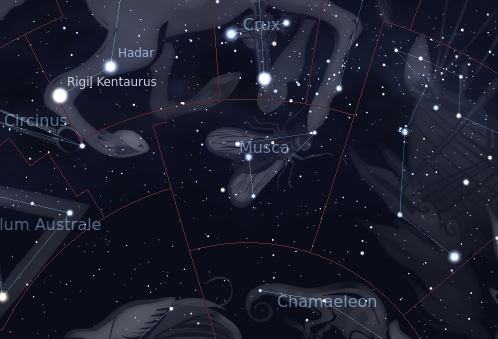
The southern fly Constellation can be spotted in the Southern Hemisphere, also referred to as the Southern celestial sky.
The Constellation Musca is surrounded by various recognizable Constellations namely:
- Apus; Circinus; Carina; Centaurus; Chamaeleon and Crux.
The identifiable outlines of these Constellations are used as a guide-point in the sky used by astronomers and amateur stargazers to identify certain Deep Sky Objects of interest.
The naming of Musca
Musca is usually associated with the name ‘the fly’, but was previously called Constellation Apis, meaning ‘the Bee’.
The Dutch astronomer Petrus Plancius is credited with creating and naming the 12 Constellations noted during the Dutch sea voyages to the East Indies in the 16th Century.
Musca is a member of ‘the Johann Bayer family of Constellations that includes (in alphabetical order):
- Apus; Chamaeleon, Dorado; Grus; Hydrus; Musca; Pavo; Phoenix; Tucana and Volans
What’s within the Musca Constellation?
The different components usually housed by Constellations are mainly Stars, Deep Sky Objects and Messier objects (galaxies).
The Constellation of Musca is formed by of a number of different components, it has:
- 6 main Stars
- 3 associated exoplanets
- 0 formally named Stars
- No associated meteor shower
- 0 Messier Objects
The Stars
There are many different types of Stars in the star system categorized by size, lifespan and luminosity.
Generally, larger Stars have a shorter lifespan.
Stars are formed from clouds of interstellar gas and include:
Red Dwarf Stars
Most of the stars in the galaxy are Red Dwarf Stars. They are small in size measuring about 40-50% of the mass of The Sun. They are cool and their luminosity has only about 10% of the brightness of the Sun (our brightest Star), and they live for longer.
Brown Dwarf Stars
These are known as failed stars that form like other stars but don’t reach the mass, heat or density to begin the nuclear fusion process. They are only about 8% of the mass of the Sun and are red not brown, and not easy to spot in the night sky.
Red Giant Stars
These are giant luminous stars that have a low or medium mass. A Red Giant Star is formed when a star expands its volume by fusing all of its hydrogen into helium, and then burning the helium to produce carbon and oxygen to expand.
Blue Giants
These are giant, bright stars that range from 10-100 times the size of the Sun and are 1000 times brighter. They are big and hot and therefore burn out quickly. The biggest are called Blue super giants or hyper giants. The biggest ever discovered was about 10 million times brighter than the Sun,
Yellow Dwarfs
These are main-sequence stars like the Sun, but only 80% of its size, and are bright stars,
White Dwarfs
These are small burnt out husks of stars, about the same size as the Earth. White Dwarfs are dense and represent the final state of evolution for a star, like most stars in the galaxy.
Black Dwarfs
These are the remains of a White Dwarf after it cools and darkens. This is likely to happen after about 10 billion years of life.
White Stars
These are also main-sequence stars like the Sun, but twice the size, and are bright stars and hot.
Other types of stars include the Orange Giant, Neutron stars, Variable Stars and Binary Stars
What is a Bright Star?
The sky is home to various bright stars.
The brightness of a star is measured by a value called its magnitude (apparent magnitude) and they come in different sizes, composition, mass and color.
Their vast distance away from us is measured in light years from the Earth, the Sun or even the Milky Way.
The lower the magnitude value the brighter the star appears in the night sky when viewed from Earth.
FACT: The Sun is considered to be the brightest star in the sky.
Locating its 6 brightest Stars, can identify the Constellation of Musca as the fly
As well as Stars and Star Clusters, the Musca Constellation also has deep sky objects and galaxies (or even globular clusters or open clusters).
Deep Sky Objects
The notable deep sky objects, includes objects from the Henry Draper Catalogue of Stars (abbreviated to HD and a designated number as an identifier), or the Index catalogue classification (IC)
FACT: A Deep Sky Object is an astronomical object, that is not a solar system object like the Sun, Moon, Comet or a Planet. An individual Star is not considered to be a Deep Sky Object.
Deep Sky Objects are faint objects that can still be observed by the naked eye in the night sky from Earth.
Deep Sky Objects include Galaxies, Star Clusters and Nebulae.
- Star clusters – such as Globular Clusters of Stars or Open Clusters of Stars
- Dark Nebula, Planetary Nebula, Diffuse Nebula, and Supernova remnants
- Galaxy Groups, Galaxies, Spiral Galaxies, Gravitational Lenses and Quasars
What is a Messier?
A Messier is a cluster of Stars
It was Charles Messier, a French astronomer, who is credited with cataloging each of the Messier Star clusters, around 1764.
He is famous for publishing an astronomical catalogue that lists 110 nebulae and star clusters, known as the New General Catalogue (used in its abbreviated form NGC and numbered).
There are no Messier object star clusters within Constellation Musca, but there are some NGC listed objects and notable galaxies:
FACT: A star cluster is a large group of Stars that can be Globular Clusters or Open Clusters:
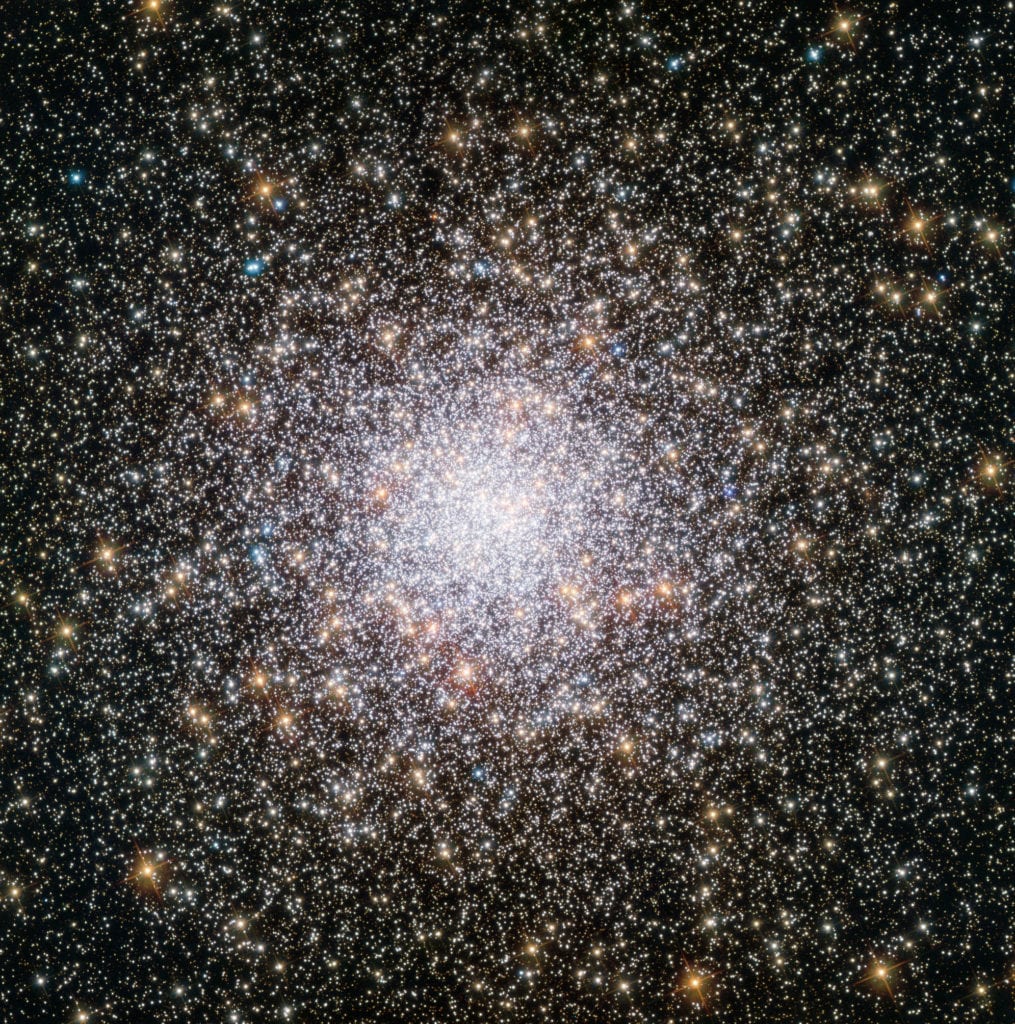
- Globular Clusters:
A global cluster is a spherical collection of ‘Old Stars,’ numbering hundreds to millions, that are tightly bound by gravity and orbits a galactic core.
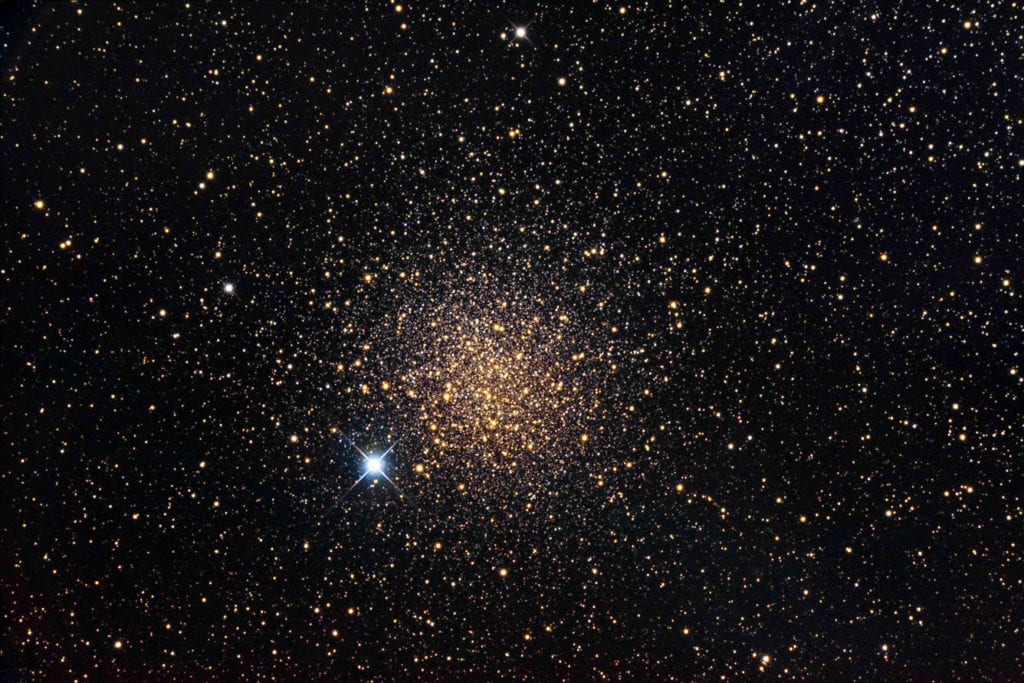
- NGC 4372 – is a globular cluster, approximately 18.900 light years distant from Earth, and has an apparent magnitude of 7.8 which means it is not visible by the naked eye.
It has a dark nebula located near it called the Dark Doodad nebula, viewed as a vertical streak at the center of this globular cluster. This long molecular cloud has regions of cloud and dust and is much closer than the center of the galaxy and located n the galactic plane.
It is one of the closest star forming areas to the Solar System.
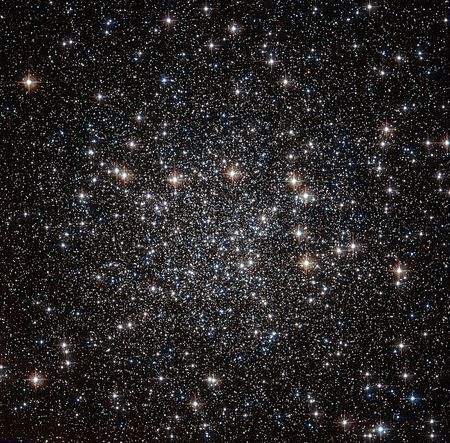
- NGC 4833 (or Caldwell 105) is a global cluster discovered by the French astronomer Abbe Lacaille, and has an apparent magnitude of 7.4
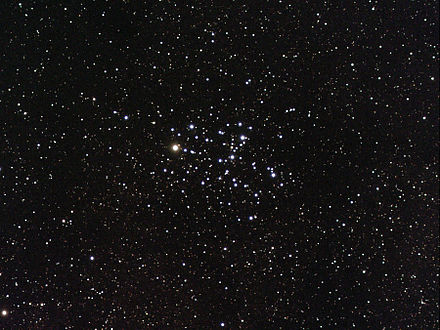
- Open Clusters:
An open cluster is a looser formation of ‘Young Stars’ that generally has less than a few hundred Stars.
What is a Nebula?
A Nebula is a massive cloud of gas and dust in Space.
Some Nebulae are formed when a star explodes and then dies, as is the case with a Supernova. Sometimes they can act as Star nurseries as areas where new Stars are forming.
The Nebulae are the spaces in between the stars referred to as interstellar space.
There are several types of Nebulae:
- Bright Nebulae,
- Emission Nebulae,
- Reflection Nebulae,
- Dark Nebulae
- Planetary Nebulae
FACT: a ‘reflection nebula’ is an interstellar cloud that should be a dark nebula (a molecular cloud) however its dust reflects light from a nearby bright star and it reflects the light, hence the name.
Notable Planetary Nebula in Musca
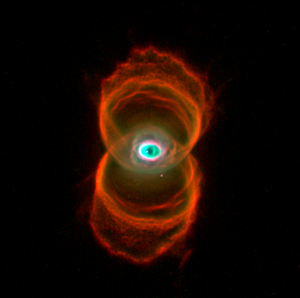
The Engraved Hourglass Nebula – (MyCn 18) a planetary nebula deep space object located around 8000 light years away, with an apparent magnitude of 13.00 It is not located in our solar system.
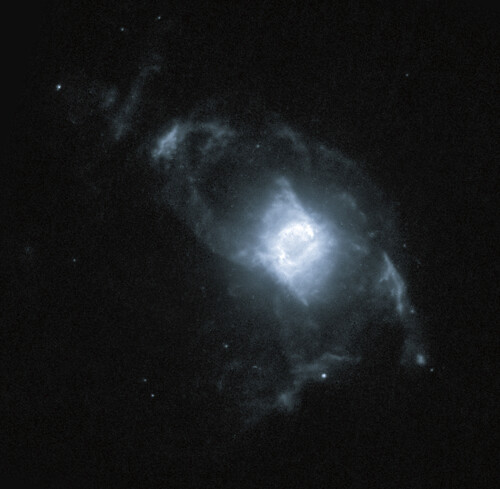
IC 4191 – a planetary nebula deep space object
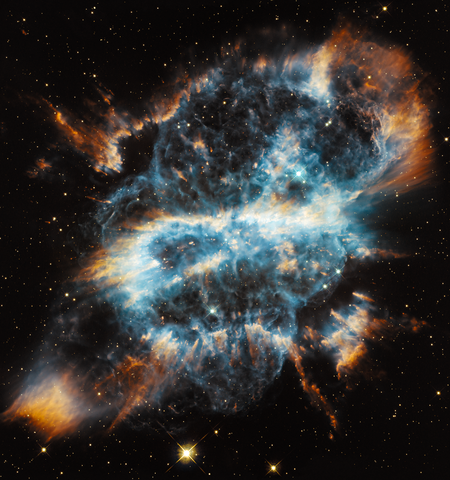
NGC 5189 – A spiral planetary nebula, that is listed in the New General Catalogue. It is around 3000 light years distant with an apparent magnitude of 8.2. It appears as an S-shape which is similar to a barred spiral galaxy and that’s how it got the name of Spiral Planetary Nebula.
Notable nebulae
Some of the best known dark nebulae are ‘The Coal Sack Nebula’, the ‘Dark Doodad Nebula’ and the ‘Horsehead Nebula.
All three are located close to each other. The Coal Sack Nebula is located in the Constellation of Crux (the Southern Cross), which overlaps with the neighboring Constellations of Centaurus and Musca.
Images of the different nebulae have been captured using a professional large telescope, such as the NASA Spitzer Space Telescope, operated by NASA, and the famous Hubble Space Telescope.
‘Musc’ is the abbreviation for Musca from a naming convention used by NASA.
Supernova Remnants
A supernova remnant is the structure that’s left after a star explodes in a supernova.
There are 3 types of supernova remnants: shell-like, composite and mixed-morphology (or thermal composite).
What is the Milky Way?
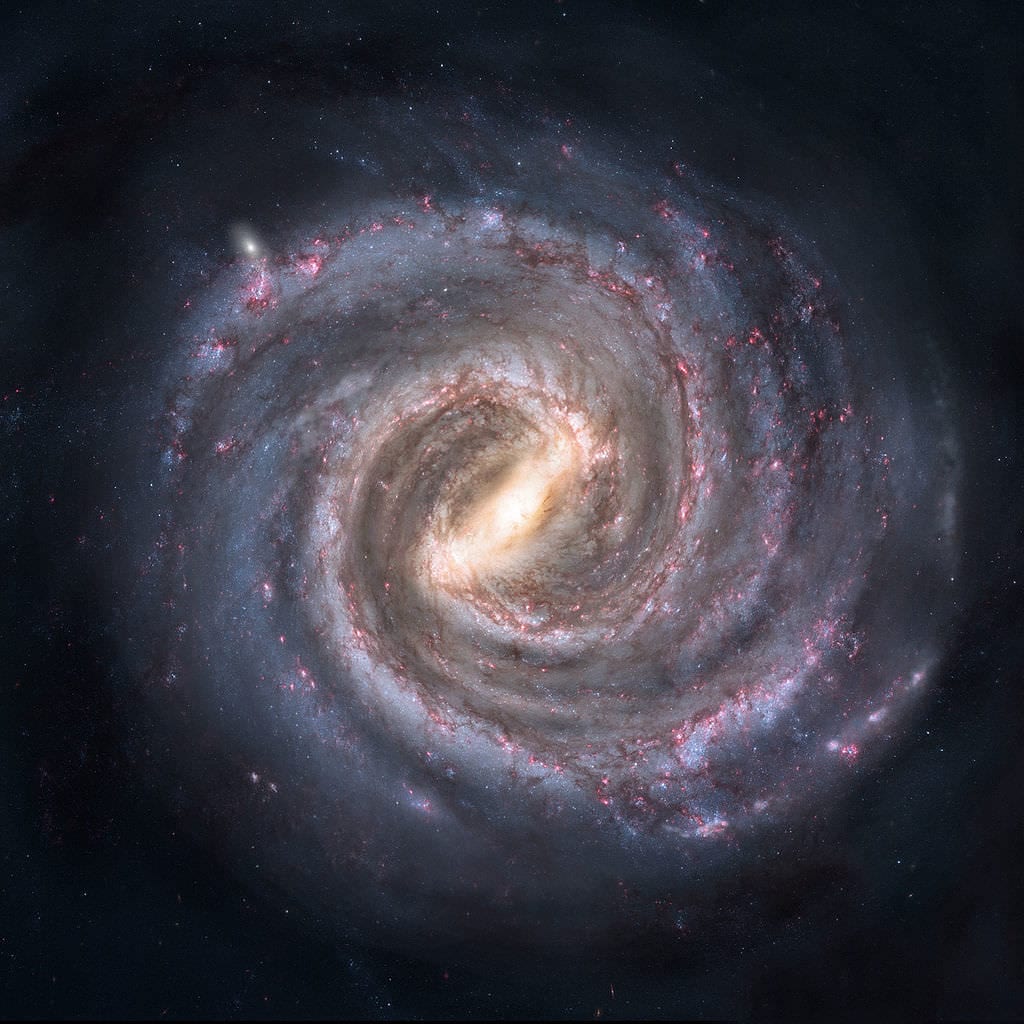
The Milky Way is a Spiral Galaxy, containing over 200 billion Stars, and actually forms part of the Constellation of Sagittarius. It is the Galaxy that contains our solar system and it gets its name from the fact that it looks like a hazy swirl or river of milk across the sky, when viewed from earth.
It is made up of gas, dust and stars, with spiral arms wrapped around it, and a massive black hole in the center of the Galaxy. Not all of the Stars in the Universe are contained within the Milky Way.
It is at its brightest if looking towards the galactic center in the direction of Sagittarius. The Stars that make up the Milky Way are many light years away and cannot be individually identified by the naked eye.
Background & Facts:
The Greeks were the first ancient culture to name the early modern Constellations in the sky.
However, in the case of the constellation of Musca there were no associated Greek myths, nor did they mention the image of a fly.
It was unlikely that the ancient Greeks or Romans would have spotted the Constellation of Musca, as it is located so far south. It was only sea voyages at that time that could view the most southern constellations on the southern hemisphere.
Ptolemy

It was Greek Astronomer – Ptolemy, who first cataloged the 48 early constellations, in the 2nd Century (2 AD.), but he did not catalogue the Constellation of Musca.
Bayer
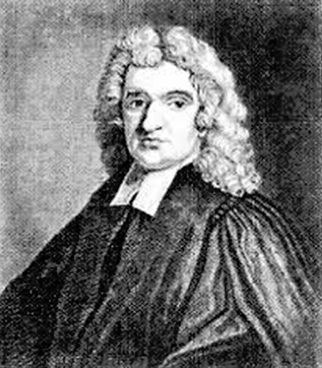
In 1603, The German Astronomer – Johann Bayer, systematically assigned names to the brightest stars in each constellation and cataloged them in his Star atlas – ‘Uranometria Omnium Asterismorum’.
The Bayer designations are stellar designations where the stars within Constellations are initially identified by a name or a letter from the Greek Alphabet from Alpha through Omega (in order of brightness).
1. The names of the Stars begin with a letter from the Greek alphabet starting with– Alpha, then beta, gamma, etc.
2. Followed by the genitive form of their parent constellation’s Latin name – ‘Muscae’
3. Giving the first Star name Alpha Muscae
The main stars of Musca are named by their apparent magnitude (luminosity) from the brightest to faintest star in decreasing order. Stars with an apparent magnitude of less than +5.0 include:
1. Alpha Mus – an apparent visual magnitude of 2.69
2. Beta Mus – a variable visual magnitude of 3.04
3. Delta Mus- an apparent visual magnitude of 3.61
4. Lambda Mus– an apparent visual magnitude of 3.68
5. Gamma Mus – an apparent visual magnitude of 3.84
6. Epsilon Mus– an apparent visual magnitude of 4.06
7. Mu Mus – an apparent visual magnitude of 4.75
8. Eta Mu – an apparent visual magnitude of 4.79
Hipparcos created the apparent magnitude system to rank the brightness of Stars (for example he decided that that the grade of a first magnitude star should be twice as bright as a second magnitude Star, and so on.
FACT: The commonly quoted ‘Hipparcos Satellite’ is an abbreviation of ‘The High Precision Parallax Collecting Satellite’, which is an astrometric satellite used by the European Space Agency (ESA)
The Bright Stars of Musca
If you look up and into the Southern night sky you can imagine the outline of Musca, as a fly.
This constellation is made up of 604 Stars in total, although only 31 Stars are visible by the naked eye.
Stars with Planets
Musca has 3 Stars with an exoplanet orbiting around it in the solar system but they are unlikely to be able to support life forms.
The three Stars with exoplanets are within the Constellation, but not part of the outline, are:
- 1- HD 111232 – a yellow main sequence Star
- 2- HD 112410 – a yellow giant Star
- 3- HD 100546 – a blue white Star
FACT: An exoplanet (also referred to as an extrasolar Planet) is a planet that orbits a Star that is not located within our Solar System (exoplanets do not orbit our Sun)
Nothing stands still in the sky.
Planets are continually being discovered and lists updated.
The Constellations change their positions throughout the year as the Earth rotates around the Sun.
This means our position in space is forever changing and as a result our view of what’s in space changes too, and will continue to do so.
The purpose of Musca –
In ancient times the dots, bright lights and perceived objects in the sky were of great interest and the makings of folklore to a great range of people from seamen to farmers.
FACT: The Star System or Stellar System is a small number of stars that orbit around each other and are bound together by gravity.
When it becomes a large group of stars, again bound together in the same way, by gravity, it is known as a Galaxy or Star Cluster.
Whether they contain small groups of stars or larger groups of start the both come under the classification of ‘Star System’.
The Musca celestial pole
The celestial pole defines the poles of the celestial equatorial coordinate system.
An object at the Celestial pole has a declination of 0 degrees
- The declinations for the north celestial pole is +90 degrees
- The declinations for the south celestial pole is -90 degrees
The celestial poles are not permanently in a fixed position against the background of the stars as everything moves in Space.
Musca is located in the Southern celestial sky at a +0 degree and -90 degrees declination, and an average 11-hours right ascension.
Navigational tools in the sky
The many Constellations in the night sky were a useful navigation tool and guide as well as the subject of legends and myths.
42 Constellations have been named after animals (like the fly or chameleon)and 29 named after an object.
Historical significance: surrounding Constellation of Musca
Myths and Stories
Many ancient civilizations have portrayed the Constellations in the sky to suit their beliefs and creations itself. They have been the subject of folklore and experiences for a very long time.
Muscais not connected with any Greek or Roman myths or gods.
Ancient associations with the constellations
For thousands of years, various cultures around the world have identified and named the constellation we know and see in the night sky as Musca.
What is the difference between a constellation and an asterism?
An asterism is a group of stars that appear to form a pattern in the night sky but with no officially determined boundaries.
It can make up part of a constellation or cross the boundaries of an official constellation or even a defunct constellation.
An asterism is a more vague assembly of stars than a recognized constellation.
The meteor showers of Musca
There are no meteor shower associated with the Constellation of Musca.
Fun Facts about Constellations – Did you know that?
- The Constellation of Musca is not one of the 12 constellations of the Zodiac, that appear when the Sun sets
- The sky is not divided equally between all the constellations
- Constellations have been represented in many cultures as signs and navigational guides.
- The symbol of animals, formed by the position of notable stars, is associated with the Constellation of Musca and also Constellations such as Scorpius and Chamaeleon.
- As the Musca Constellation is made up of Stars that are in many different locations and vast distances from each other it is now possible to go to just one location to view it. It is visible from many different locations.
- The average distance to the main Stars in the small Southern Constellation Musca is around 250 light years away. As this Constellation is made up of a range of stars in different locations and distances away it is not possible to go to just one specific location to see it.
- Charles Messier the French Astronomer who cataloged the Messier objects has a crater on the Moon named after him.
- Constellations like Musca are not part of our Solar System; they are groups of stars that appear to form shapes that are visible with the naked eye from Earth.
- A Constellation does not actually exist as a fixed object, it is a group of bright stars that happen to be in a random place and are light years apart and ever moving. We see the pattern of their presence.
- The center of a Galaxy does not contain a Giant Star it contains a Supermassive Black Hole.
- A Red Dwarf is not a Dwarf Planet it is a Star. Most common Stars are Red Dwarf (cool Stars)
- Spiral Galaxies make up about two thirds of all the Galaxies in the Universe
Commonly Asked Questions
Q. What is the celestial sphere?
A. In astronomy and navigation terms, the celestial sphere is imaginary.
This virtual sphere has a large radius that is concentric with Earth.
We can imagine all objects in the night sky as being projected upon the inside of this celestial sphere, as if it has images placed inside a dome.
Q. What’s the difference between a Constellation and an asterism?
A. The stars that make up a Constellation have a definite position and form, whereas an asterism is a collection of stars without a fixed position
Q. What prevents us seeing the Stars and Constellations in the night sky?
A. Light pollution, fog, city lights and artificial lights all limit our visibility of the objects in the sky at night.
Q. Will the Constellations change over time?
A. The Constellations are continually on the move.
The images we form in our imagination to make objects, shapes and patterns out of the constellations have already shifted over time.
As we view the night skies from Earth they are likely to continue to shift and possibly in time the images may look very different.
SOURCES:
- https://www.vectorstock.com/royalty-free-vector/musca-constellation-with-beautiful-bright-stars-on-vector-9177897
- https://in-the-sky.org/data/constellation.php?id=57
- https://astronomynow.com/2016/10/24/hubble-reveals-ngc-362-a-young-globular-cluster
- https://www.wikiwand.com/en/List_of_open_clusters
- http://www.astrosurf.com/antilhue/ngc4372.htm
- https://en.wikipedia.org/wiki/NGC_4833
- https://en.wikipedia.org/wiki/Engraved_Hourglass_Nebula
- https://www.flickr.com/photos/geckzilla/10949396984
- https://en.wikipedia.org/wiki/NGC_5189
- https://sedsvit.medium.com/just-us-d4ab577099a2
- http://www.hellenicaworld.com/Greece/Science/en/PtolemyAstronomy.html
- https://alchetron.com/Johann-Bayer